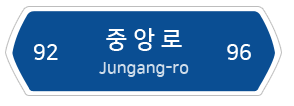There are two separate address systems which exist simultaneously in Korea despite one officially being phased out in 2013. The older system, sometimes translated as the land-lot number address (지번 주소, 地番 住所, jibeon juso) resembles that used in North Korea and Japan. It is ordered from largest to smallest units and based on dividing by city (시, 市, si), then district (구, 區, gu), and neighborhood (동, 洞, dong). (To read more about district zoning and a detailed differentiation between dong, gu, si and others, click here.) Next the city block (번지, 番地, beonji) which could be several dozen to several thousand per neighborhood, then the building number is given (호, 戶, ho ). Often the markers 번지 and 호 were skipped and their numbers were separated by a hyphen. The floor (층, 層, cheung) and apartment or suite number (호, 號, ho) and receptient’s name were written last. It is worth noting that this address and a street address are not the same thing as no street name is mentioned. The old system was officially decommissioned on December 31, 2013 but is still widely used.
Sometimes called the road name address, the new system resembles addresses in North America and Europe as it is based on street names. There are two names for it in Korean; 새주소 (새住所, saejuso) which means new address and 도로명주소 (道路名住所, doromyeong juso) which translates into road address. It underwent a pilot program in 1996, new street signs were installed between 1997 and October 2010, various notices and announcements were sent for several following years, and the new system officially started January 1, 2014.
The newer system also starts with the biggest unit; the city. The district follows, then the street name, a dash, and then the street type, which could be a boulevard with over eight lanes (대로, 大路, daero), road with 2 to 7 lanes (로, 路, ro) or street for anything else (길, 街, gil). Other road types exist but these are the most common.
Next the building number and unit number are given. As many people live in apartments, let's use a related example: 102동 304호 or 102-dong 304-ho but sometimes a simpler format of 102-304 is used. The 1 value is shared with all the apartment buildings for that company in that area and the 2 will indicate one specific building among in that group. The 3 in the example stands for third floor. And the 4 is for an individual unit. Lower costing apartments will have one elevator per floor and “better” apartments will have an elevator service only two units per floor. Simple math shows that for eight units per floor there will be four elevators; units 1 and 2, 3 and 4, 5 and 6, and finally 7 and 8. Each of these is sometimes written as 호 (ho) or 라인 which is the loanword “line”. As our sample tenant lives in 304, he/she lives in the 3~4 line and only that elevator will provide access to their home. Lastly, the recipient's name is written.
As some underground parking lots provide access to multiple buildings, the signage needs to tell people not only which line an elevator accesses, but which building as well. Here are some images taken from one underground apartment parking lot. Both signs are referencing the same elevator and ajoining stairs. The sign on the left uses 1-2호 and the right image states 1~2라인 and both are for apartment building 206.
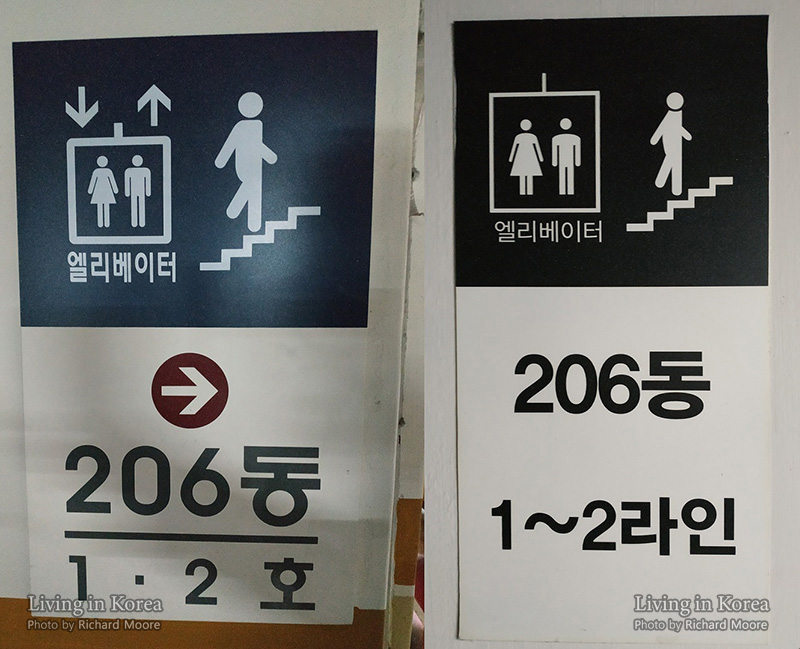
If you flip over your Residence Card the back will display your address in the new system and then again with some of the old system in parenthesis.
For more information on the new address system, check out the Road Name Address website created by the Ministry of the Interior and Safety. More details are in their 15-page online book with PDF download. If those direct links no longer work, visit www.juso.go.kr, click “English” at the top right, and then “Introduction” on the top left. For more examples of address and information on the newer address system, check out the related page on Wikipedia.
Here are some examples of address signs. The images have been copy-pasted from the Road Name Address website created by the Ministry of the Interior and Safety and the wording has been modified for clarity.
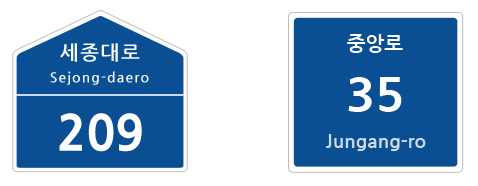
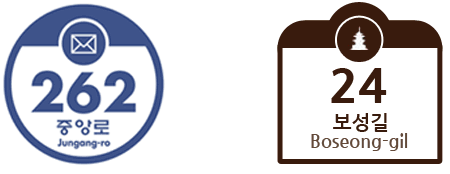
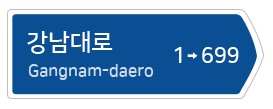
Gangnam-daero
The boulevard Gangnam-daero starts from here
1 ->
The sign is posted near building #1
1 -> 699
The length of Gangnam-daero is 6.99 km (699 x 10 m)

Daejeong-ro 23beon-gil
The 23 indicates this is a side road 230 meters from the start of Daejeong-ro
<- 65
The sign is posted near building #65
1 <- 65
The length of Deajeong-ro 23beon-gil is 650 m (65 x 10 m)
